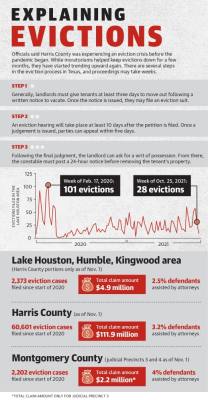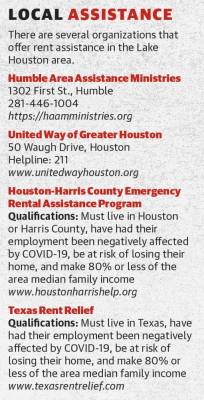In Harris County, 53% of residents worry about whether they will be able to stay in their homes due to the rising financial burden, according to a study by Rice University’s Kinder Institute of Urban Research released Oct. 19. Of low-income families who are earning less than $50,000 annually with children, 18% have moved in the last three years due to rising housing costs, while 21% wanted to move but could not find affordable housing.
Of all residents living in Humble and New Caney ISDs, 12% and 11%, respectively, moved into their homes in the last two years, according to 2019 data from the U.S. Census Bureau.
“We know that rents have gone up faster than wages, and people were struggling pre-pandemic,” said Leah Barton, director of strategic initiatives with the Office of County Administration. “As people experienced loss of jobs—or in many cases even if they kept a job, loss of hours—and increases in expenses, ... they’ve really felt the squeeze.”
Almost 500,000 households in Harris County are considered “cost burdened” by housing, meaning more than 30% of their income is used to pay for their residence, as of April, according to the Kinder Institute. From 2014-18, about 50% of Montgomery County renters were considered cost burdened by housing, according to the U.S. census, and about 23% of homeowners were considered cost burdened.
As housing becomes a larger share of the budget for many families, Barton said some may be forced to cut back on other necessary expenses.
New coronavirus cases and deaths in Texas have trended downward since early September. However, rent prices and housing prices have risen to levels higher than they were pre-pandemic in the Lake Houston area.
Fast-moving markets
The housing and rental markets have also been affected by the pandemic with the price of single-family homes rising alongside rental prices and occupancy rates.
In September, Lake Houston-area rental and occupancy rates peaked with an average rent price of more than $1,174 per month and an occupancy rate of about 93%, according to ApartmentData.com. By comparison, rental occupancy was at about 87% and monthly rental rates averaged $1,033 in October 2019.
“The supply for single-family homes has dropped, and that drives prices up,” ApartmentData.com President Bruce McClenny said. “Traditionally, there’s this movement from renters to be buyers of homes, and that has been disrupted in a big way.”
Data from the Texas A&M Real Estate Research Center shows home prices have climbed and the amount of inventory has plummeted throughout the pandemic in the Lake Houston area. In two local market areas in the region—East Kingwood and South Atascocita—median home sale prices rose 21% and 30%, respectively, from September 2019 to September 2021. In that same time period, the months of inventory, or the time it would take to sell all properties for sale at the average sales price, declined 77% and 59% for both areas to about one month of inventory for each.
Kingwood resident Mary Kolenovic moved into her single-family home in September after she began looking for a new home about two years ago and began bidding on homes in April.
"Every time we found something we liked, within like 24 hours it was gone. ... It went so fast,” Kolenovic said. “We found this house; we put in a bid; they accepted, and it was like I had to hurry up and put my house [up] for sale. And then my house sold [for] full price within 11 days.”
However, the lack of affordable housing in the Greater Houston area, including the Lake Houston area, is a problem that predates the pandemic, said Ester Valladares, the program director for the Humble Area Assistance Ministries.
“[During] the last [few] years, between natural disasters in our areas and now COVID-19, [which] only made it worse ... affordable housing is a great need, and it impacts everything, [including] health [and] wellness,” Valladares said.
Facing eviction
Evictions are beginning to trend up again throughout Harris County, officials said. More than 1,400 cases were filed the week of Oct. 11, according to reports by data science consulting firm January Advisors, which was the highest weekly number since before the pandemic.
Within HISD’s boundaries, 75% of families owned homes, while 25% rented, according to U.S. Census American Community Survey estimates for 2014-19. For NCISD residents, about 68% of residents were homeowners, and 32% were renters.
Passed in March 2020, the federal Coronavirus Aid, Relief and Economic Security Act included an eviction moratorium through late July 2020. By September 2020, the Centers for Disease Control and Prevention issued its own national eviction moratorium, which officials hoped would slow the spread of COVID-19.
While evictions dropped in Harris County during the pandemic, moratoriums were not consistently enforced, according to January Advisors. Based on the firm’s data, more than 60,000 eviction filings had been made in Harris County, including about 2,300 in the Lake Houston area, since the start of 2020 as of Nov. 1. In Montgomery County’s judicial precincts 3 and 4, 2,202 eviction cases were filed between January 2020 and October 2021.
Local apartment complexes that have filed the most eviction cases include 84 filed by Bellaterra at Deerbrook, 66 at Haverstock Hills Apartments and 65 at Carrington, according to January Advisors. These landlords did not respond to requests for comment as of press time.
After multiple extensions, the CDC’s moratorium ended late this summer. Workforce Solutions data shows the Houston region’s unemployment rate was about 6.1% at the time. A report from January Advisors revealed the CDC’s moratorium delayed or prevented evictions for 13% of defendants in Harris County.
Local resources
Renters needing assistance have a few options. The Houston-Harris County Emergency Rental Assistance Program had pledged or paid over $221 million to more than 57,000 families as of mid-October, most of which was subsidized by federal funds.
Another option is the Texas Rent Relief program, which has paid about $563 million in rental assistance to applicants. More than 53,350 households have been assisted in Harris County through this program, and more than 2,673 have been assisted in Montgomery County.
Valladares said while HAAM assists Humble-area residents with rent, it does not have the resources to help every applicant.
“We have been assisting families in our area to complete applications that will assist with rent,” Valladares said. “However, not everyone that we helped with the applications will be chosen. Funding is limited.”
Since the pandemic’s onset, United Way of Greater Houston has been focusing on helping residents who are considered asset limited, income constrained, employed, or ALICE. According to United Way, 64% of Humble residents are considered ALICE or below, while 47% of residents in the Greater Houston area fall into this category.
“For solutions to be effective, they really must be comprehensive and interconnected to really address the multiple and many areas of struggle that a family or household might encounter,” United Way ALICE expert Jessica Davison said.
Sierra Rozen contributed to this report.









